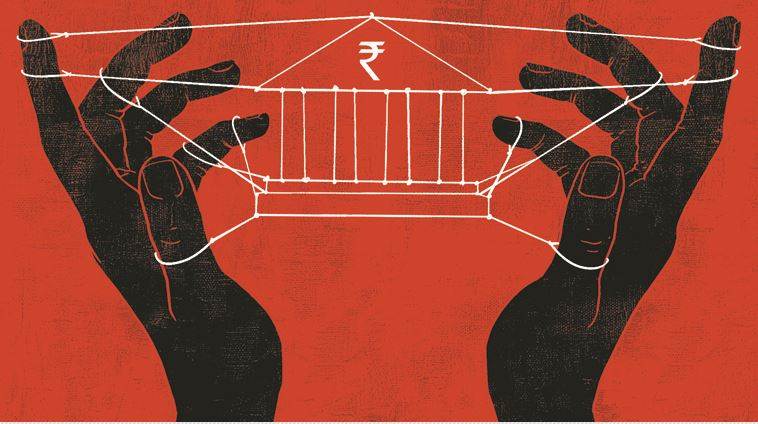- India
- International
Surely, 50 years is a good time to review bank nationalisation
Fifty years after bank nationalisation, banking is still seen as an enterprise driven by social purpose and political considerations — not depositors’ interests. This needs to change.
 Illustration by Suvajit Dey
Illustration by Suvajit Dey
Fifty years ago, after her government issued an ordinance on July 19, 1969 to nationalise 14 banks which had deposits of over Rs.50 crore, Prime Minister Indira Gandhi addressed the custodians of these banks at the end of September 1969.
In that meeting, she told them that banks, being closely linked with the development of the economy, could not remain uninfluenced by the needs of the political situation. “The political situation in our country today demands that banking facilities should be extended in an increasing measure to backward areas, to agriculture, to small-scale industry and so on and perhaps banking operations should be informed by a larger social purpose. But if this is what is meant by political consideration, certainly, there is political consideration.
But if by that phrase they mean that in their day-to-day working, those in charge of the banks might be influenced by extraneous considerations, unrelated to public welfare or economic development, then I have no hesitation in assuring you that as long as I am in charge, such considerations will not be allowed to interfere with your work,” she said.
The Prime Minister went on to tell the custodians of those banks that within the broad policy framework laid down by the government, they would have the necessary freedom and latitude to function as efficient and professional bankers, guided solely “by your conscience and the canons of the profession to which you belong”.
Her political survival instincts — with the challenge from the old guard in the Congress to her leadership — prompted Indira Gandhi to embark on this move at a time when a law on social control of banks had just kicked in, ignoring the views of Deputy Prime Minister and Finance Minister Morarji Desai and the industry, which was opposed to the state taking over private banks. But as she said in her broadcast to the nation on July 19, “Control over the commanding heights of the economy is necessary, particularly in a poor country where it is extremely difficult to mobilise adequate resources for development and to reduce inequalities between different groups and regions “.

Over the last five decades, control over some important parts of the so-called commanding heights of the economy has been eased by successive governments. Indian banking too has changed in terms of reach and penetration, formalisation of credit, channelising savings for investment and for funding anti-poverty programmes, products offerings, service quality, efficiency, credit support to industry and other segments including in rural areas, helping to reduce regional disparities and boosting economic growth.
Consider this: In July 1969, at the time of nationalisation of banks, there were just 8,262 bank branches in the country. At the end of June 2018, state- owned banks alone had built a network of branches or a franchise of over 90,000 (over 29,000 in rural areas) and over 1.45 lakh ATMs while private banks had 28,805 branches.
Some of the objectives of that political move in 1969 may have been achieved in the first decade or two. But what has remained unaltered in the last 50 years despite economic reforms is the political philosophy and belief echoed by Indira Gandhi on banking — a commercial enterprise driven by a larger social purpose and political considerations. It is on this that there has been a strong political consensus across successive governments irrespective of ideology, oblivious of the fact that the fundamental obligation of banks is to depositors.
The political pay-offs are evident when the government retains control over these lenders. A case in point: The repeated instances of waiver of farm debt.
In the era of brick-and-mortar banking- administered interest rates and monetisation of debt, these may have worked. But not in a world where besides competition, rapid technological changes and innovation are transforming the way banks operate and when the government is struggling to cope with competing demands such as funding infrastructure projects, social sector programmes and delivering public goods. The result: Private banks have managed to chip away at the share of PSUs.
However, the political philosophy reflected in the continuing ownership of many banks has come at a huge fiscal cost and poses a risk to financial stability. In the last five years alone, the recap tab at over Rs.3 lakh crore is far in excess of the aggregate funds, which many governments had infused over close to three decades, indicating the scale of the problem.
Key financial indicators of many of these public-listed banks reflect the deterioration. At the end of March 2019, gross non-performing assets as a percentage of total advances rose to 11.2 per cent while the return on assets for PSU banks in FY 2018 was – 0.8 per cent with return on equity, another metric to measure the performance of banks, also being negative. Interestingly, last fiscal, the opening of new branches declined by 25 per cent according to RBI data, as banks chose to rationalise and cut spending to contain costs.
The consequences of all these are not just an aversion to risk but also an unwillingness to reduce lending rates sharply even when the RBI has cut interest rates by 75 basis points this year because of the need to set aside funds for potential loan losses — all of which defeats monetary policy signaling or transmission or the provision of adequate credit, and the broader aim of reviving investment.
As the dominant shareholder, the government has to constantly find resources to capitalise and strengthen banks given that the returns on such investment are now negative. It is that pressure which is now forcing the government to push the Indian central bank to transfer a good part of its reserves to limit its fiscal deficit.
The Vajpayee-led government did make an attempt to break from the past. Finance Minister Yashwant Sinha sought to introduce a bill in Parliament seeking to lower the government’s equity in banks to 33 per cent. That he reckoned would enable banks to raise fresh capital without any major dilution of management control. The proposal was jettisoned by the government. The UPA government which succeeded it, reinforced sovereign control over state-owned banks through law.
If the original sin was nationalisation, as some would put it, the second sin was allowing universal banking in early 2000, prompting banks to foray into infrastructure financing in the space vacated by development financial institutions, inflicting serious damage to their balance sheets.
Subsequent regimes have tried to pursue consolidation of banks. This is a politically less fraught affair compared to the option of privatisation but does not address the fundamental issue of governance, incentive structures for bankers, dual control and the separation of ownership or the distancing of the owner, the government from the management of the bank.
The model of banking being driven by political considerations and ownership control worked up to a point. It will now have to be undone. Social control may work with a regulatory fiat irrespective of the ownership structure. The emergence of more efficient channels of intermediation, driven by technology and marked by cashless transactions and which can reach out to unbanked families to offer credit and new financial products, better regulation and supervision and using the private sector to deliver services competitively, should help as the government makes the transition. The grand bargain politically could be to retain control of India’s largest bank, State Bank of India, while divesting shareholding in most banks.
The history of reforms in India show that the toughest policy changes have often been carried out in the first two years of a government as in 1991-92 during the Narasimha Rao government and later, during the Vajpayee and UPA governments, There has been little political appetite for reforms since. Shortly after the global financial crisis, the-then US President, Obama in a speech in 2009 said,“Governments should practice the same principle as doctors: First do no harm. So rest assured, we will do whatever is necessary to get credit floating again, but we will do so in ways that minimise risks to taxpayers and to the broader economy”. Surely, 50 years is a good time to review bank nationalisation. India’s tax payers would also want its government to adopt the principle of doctors.
This article first appeared in the print edition on July 19, 2019 under the title ‘The original sin’. The writer is consulting editor, The Indian Express
EXPRESS OPINION
Apr 25: Latest News
- 01
- 02
- 03
- 04
- 05










































